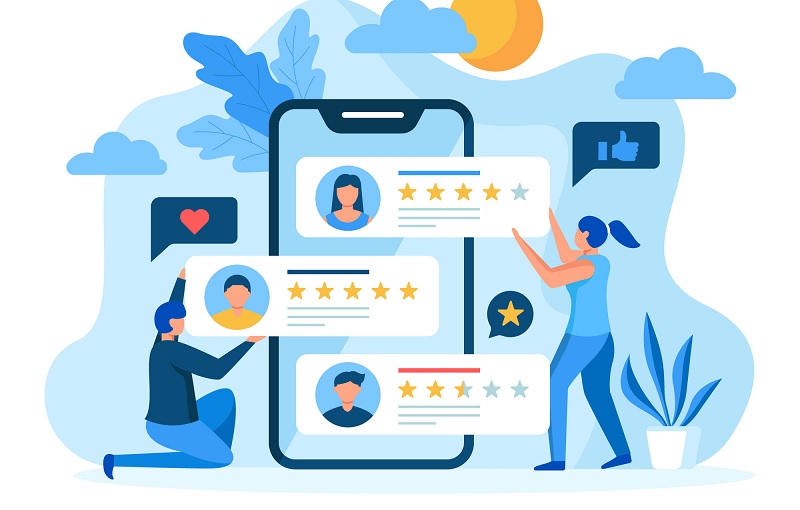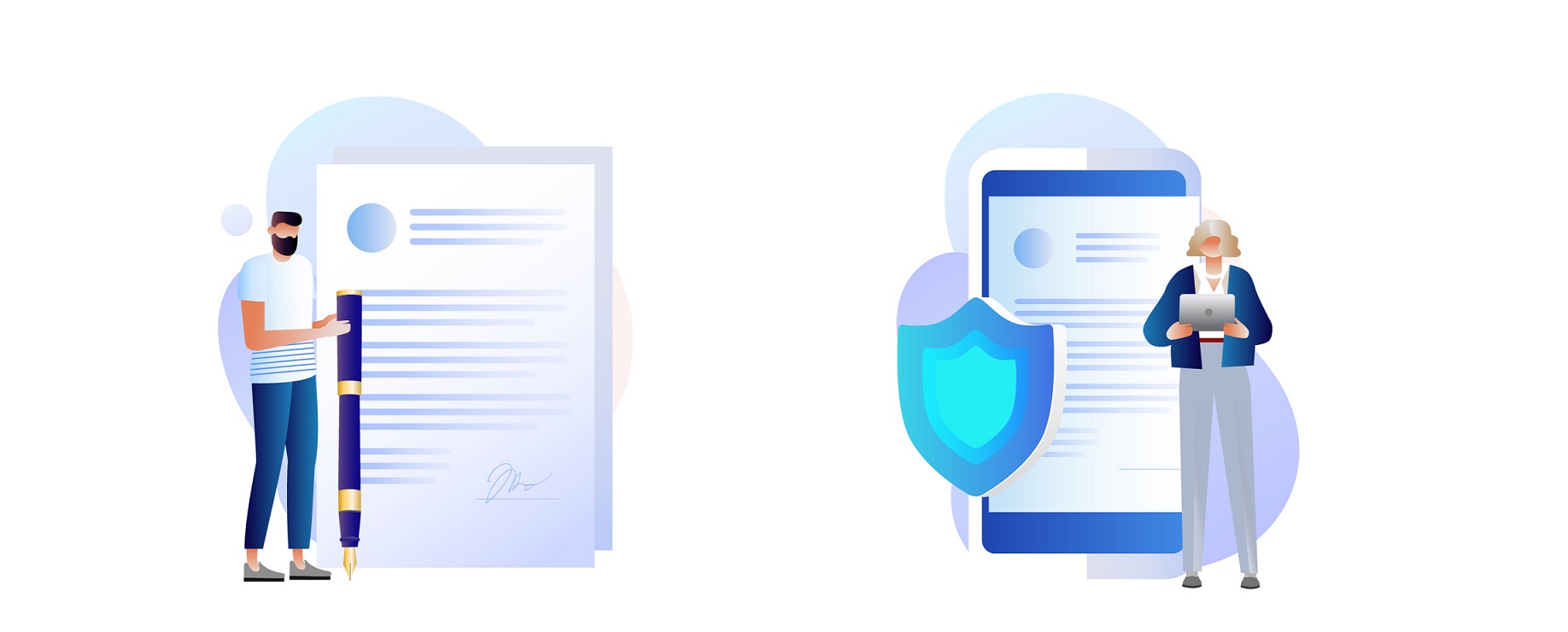
You don’t need to dig all that deep under the surface to know how important customer satisfaction is, right?
I mean, it’s pretty simple:
Satisfied customer, good. Dissatisfied customer, bad.
The thing is, though, it’s not always so black-and-white.
What Is Customer Satisfaction?
Customer satisfaction is a measure of how well a product or service meets or exceeds the expectations of a customer. With that said, you can think of customer satisfaction as more of a sliding scale—one that’s constantly in-flux based on a customer’s most recent experience with your brand.
And, as a given customer’s current level of satisfaction fluctuates, so, too, does their propensity to engage with your brand.
This makes customer satisfaction an important factor for your business as it's a true leading indicator of future sales: generally speaking, the more satisfied your customers are, the more likely they are to make future purchases from your company.
Customers making more purchases from your company sounds great, right?
Of course! But how do you go about creating a great experience for your customers that ensures that they're completely satisfied with their interaction with your company?
In this post, we're going to show how to exceed customer expectations as we discuss:
- Why customer satisfaction is so important
- What customer satisfaction is really all about
- How to monitor and measure customer satisfaction
- Ways to improve customer satisfaction
Why Is Customer Satisfaction Important?
For one thing, the probability of selling to a current, satisfied customer ranges from 60 to 70% (while the probability of selling to a new customer is at most 20%).
Basically, the more likely they are to do repeat business with your company in the first place, the less effort it will take on your part to get them to do so.
Along with this, you also don’t need to spend near as much to keep your satisfied customers on board as you do when bringing aboard newbies.
Depending on your industry, the cost of acquiring a new customer can be anywhere from 5-10x that of retaining your current ones.
Finally, consumers not only make more purchases as their satisfaction levels rise, but they also spend more altogether.
That is, your loyal and satisfied customers aren’t merely buying up more of your lower-priced products; they also set their sights on your more big-ticket items, as well.
All this being said, it’s important to note that the relationship between customer satisfaction (or dissatisfaction) and customer retention isn’t a direct one. Rather, the relationship looks more like this:
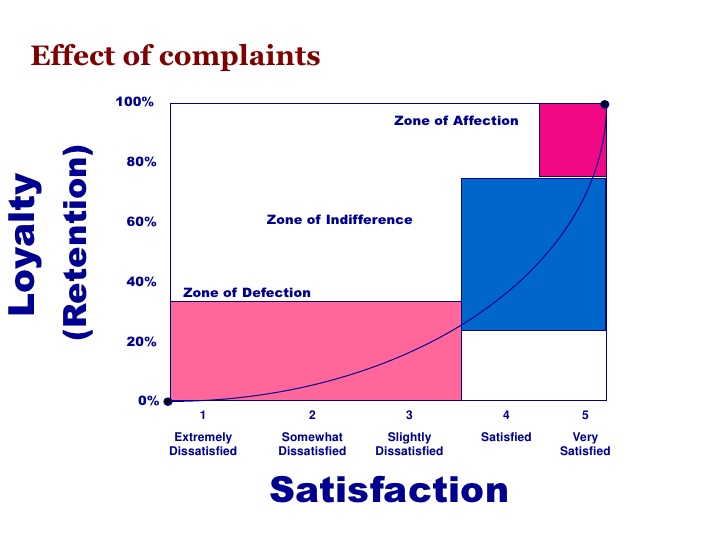 (Source)
(Source)
As Keinengham and Vavra explain in The Customer Delight Principle, providing “mere satisfaction” isn’t enough, here.
To truly maximize your chances of retaining your customers, you need to ensure they’re not just content with the service you’ve provided them—but that they’re completely blown away.
Now that you see the benefits to ensuring truly satisfied customers, let's discuss the main drivers of customer satisfaction.
What is Customer Satisfaction Really All About
While a lot of “little things” go into ensuring your customers’ satisfaction (which we’ll get to in a bit), it really all boils down to your ability to cater to your customers.
That is, it’s all about the customer’s expectations from your company and your ability to live up to those expectations.
Essentially, customer satisfaction = performance - expectations (as summed up by CCXP Annette Franz of CX Journey).
So what do your customers expect from you?
It comes down to the following three principles.
Be Responsive to Their Needs. On an individual level, this means responding immediately to inquiries and help desk tickets (even if only to acknowledge and reassure the customer at first to ensure they feel you’re taking their issue(s) seriously ).
On a macro level, responsiveness involves making overarching changes to the customer experience your brand provides based on feedback and other metrics.
Be Helpful. This is pretty straightforward and obvious: Your product or service needs to efficiently help your customers overcome their initial pain points. Additionally, your service and support team needs to be just as efficient (if not more so) in solving any unique problems your customers may have as they use your product or service.
Be Attentive. While this involves being responsive and helpful in terms of providing business-related services, it also refers to the more human side of the relationship. That is, your individual customers expect you to be attentive to their individual needs as consumers and as people.
"Customer expectations have advanced to wanting experiences that are: simple, convenient, effortless, personalized, relevant, and consistent (over time and across channels)." - Annette Franz, CCXP, CX Journey.
(Note: Keep these expectations in mind for later, as we’ll bring them back up when discussing how to go about improving customer satisfaction.)
Before we do that, let’s talk about how to measure customer satisfaction in the first place.
Measuring Customer Satisfaction
To be sure, customer satisfaction is subjective from industry to industry and audience to audience.
In other words, what might be an expectation in one industry might be considered above-and-beyond in another.
For example, the typical attentiveness provided by your average B2B company would probably blow the average B2C customer away. Similarly, if you’re used to eating at McDonald’s, you’d likely be amazed at the service at even a subpar “five-star” restaurant.
That said, it’s not enough to simply do all the things you’re “supposed” to do to satisfy the “average” consumer.
Rather, you need to have a solid plan for measuring your customers’ satisfaction levels—and for using this data to improve your customer experience moving forward.
Now, while you will need to actively track your customer satisfaction metrics as well as collect additional information as you get started, it’s important to realize you likely already have access to a ton of relevant data right now.
In terms of quantitative data, you can take a closer look at your:
- Customer satisfaction score, customer effort score, and net promoter score
- Retention and churn rates
- Number of complaints over a certain period of time as well as complaint-to-resolution ratio
(Note: Such quantitative metrics can give you an idea of where your strengths or weaknesses lie—but that’s all they can do. To get more specific regarding how to proceed, you’ll need to dig deeper.)
On the qualitative side, you’ll want to dig into:
- Your product or brand reviews left by customers on your site as well as any third-party sites
- Mentions on social media, either formal ratings as well as informal comments and mentions
- Any other such feedback you’ve already collected from your target audience such as from open-ended questions on a survey, customer interviews, and customer focus groups
As we said, you’ll also want to begin actively soliciting information related to customer satisfaction, as well. Aside from the main benefit of getting a better feel for your customers’ expectations, this also gives you the opportunity to prove that you truly care about helping them succeed.
And, as Annette Franz (CCXP) notes, "it also allows you to measure how well you're performing against their expectations."
Perhaps the most common method of collecting this information is via a customer satisfaction survey.
Through these questionnaires, you can learn more about what they want from your company, and also gauge your company’s ability to provide for these needs from the customer’s perspective.
Again, it’s not about providing a specific “something”; it’s about the value your customer receives from their experience with this “something” that really matters.
At any rate, it's helpful to use a combination of qualitative and quantitative measurements to get a more comprehensive understanding of how satisfied customers are with your company's offerings.
1. Quantitative Customer Satisfaction Measurements
Quantitatively, you’ll want to collect data relating to your brand’s:
- Customer Satisfaction Score (CSAT) - This is a simple and commonly used method that involves asking customers to rate their satisfaction on something as simple as a 3-point smiley rating system, or using a similar rating system. The average score can then be calculated and used as an indicator of overall customer satisfaction.
- Customer Effort Score (CES) - This measures the effort required by the customer to complete a task or process, such as making a purchase or resolving an issue. Customers are asked to rate their experience on a sliding scale, with higher scores indicating lower effort.
- Net Promoter Score (NPS)- This is a measure of customer loyalty and involves asking customers how likely they are to recommend a product or service to others on a scale of 0 to 10. Customers are then classified as promoters (9-10), passives (7-8), or detractors (0-6). The NPS is calculated by subtracting the percentage of detractors from the percentage of promoters.
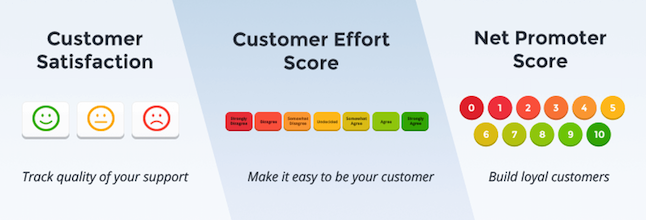 (Source)
(Source)
You can then compare your data to your competitors’ and industry average to see where your company stands.
As time goes on, you’ll also be able to compare your current score with that of previous months or years.
You’ll also want to develop additional surveys regarding more specific topics relating to your services, as well.
You can then quantify this information to analyze trends and identify and assess any “problem” areas with your service.
2. Qualitative Customer Satisfaction Measurements
Qualitatively, it’s also important to give survey respondents the chance to explain their answers in certain instances.
The more complete and authentic your customers’ answers are, the more reliable—and valuable—the information they’re providing you is.
Now, when creating these surveys, there are a few things you need to do to get maximum value out of the initiative.
First, you need to ensure that the information you’re asking for will allow you to make improvements to your customer experience in ways that matter to the customer.
You don’t want to go through the trouble of collecting a ton of data, only to realize that it doesn’t really tell you all that much.
Secondly, you also need to ensure the information you’re asking for is the information your respondents end up providing.
While receiving unusable information is bad enough, receiving inaccurate data (with no way of knowing it’s inaccurate) can be much worse for your company.
That said, you need to make your surveys easy to understand and respond to, while also eliciting in-depth, laser-focused information from your customers in the process.

(Source)
As we’ll revisit throughout the rest of this article, staying up-to-date with these quantitative and qualitative metrics is essential in order to ensure maximum customer satisfaction.
After all, you can’t improve your services if you have no idea where to start, right?

(Source)
9 Ways to Improve Customer Satisfaction
By now, you probably have a pretty good idea of why customer satisfaction is so important and how to measure it.
Now it's time to discuss how to actually improve customer satisfaction so that your business can reap the benefits.
Let’s dive in.
1. Put the Customer at the Center of Your Business
Simply put:
Without your customers, your business wouldn’t exist.

(Source)
So it just makes sense to consider the customer first and foremost when making any type of decision within your company.
Taking a step back, it’s essential to realize in the first place that every decision you make impacts your customer experience in some way or another.
Whenever a business decision or choice is to be made—no matter how minor or inconsequential it may seem—you need to ask your team:
“How will this affect our customers’ experience with our brand?”
While this might sound obvious in terms of customer-facing decisions, internal changes within your organization can also indirectly impact your customers experience, as well.
As a rather simple example, let’s say you switch to a different supplier for your retail store in the interest of saving on delivery fees.
A few months down the line, the new supplier is a week late with its shipment, leaving your company late on your individual deliveries. Unfortunately, your customers are the ones that end up suffering, here.
While digging into the nuances of customer centricity go beyond the scope of this article, we’ll quickly refer to Deloitte’s guide to embedding customer centricity into your organization’s DNA.
The keys to doing so are:
- Developing visible, customer-focused leadership
- Gaining a true understanding of your customers
- Designing CX with this true understanding in mind
- Empowering your customer-facing frontline
- Including the back office in customer-facing discussions
- Collecting metrics and feedback that matter
- Taking tangible action
As you can see, many of these principles align with the keys of customer satisfaction as a whole.
That’s because customer centricity goes hand-in-hand with satisfying your customers.
In other words, by putting your customer at the center of your business, you inherently guarantee that everything you do will lead to them becoming more and more satisfied with the services you provide.
"Customer-centric companies put the customer at the center of all they do; they don’t make any decisions without thinking about the customer and the impact that the decision has on the customer. As a matter of fact, I’ve heard from many brands who have copied Jeff Bezos’ ‘empty chair’ approach to always ensuring that the customer is represented in meetings and decisions. (It goes without saying that Amazon is a prime example of customer obsession.) Customer-centric companies also bring the voice of the customer into both product design and service design.” - Certified Customer Experience Professional (CCXP), Annette Franz, CX Journey.
2. Treat Your Customers by the Platinum Rule
Piggybacking off of customer centricity, another key to satisfying your customers is treating them by the Platinum Rule.
While it’s easy enough to tell your frontline employees they need to “treat the customer the way they’d like to be treated, (AKA the Golden Rule)” this is a bit misguided (and a bit trite, if we’re being honest).
The problem with the Golden Rule is that it puts the focus back onto the company. Operating under the Golden Rule is essentially saying, “We treat our customers the way we think they’d like to be treated, based on how we’d like to be treated.”
The Platinum Rule, on the other hand, flips this on its head. This rule states that you should treat your customers (or, “others” in general) the way they’d like to be treated.

(Source / I guess Discover’s “We treat you like you treat you” campaign is onto something.)
This will allow you to avoid a variety of potential pitfalls, such as:
- Making assumptions about your customers’ expectations
- Developing features and services your customers don’t find valuable
- Indecision as to how to enhance and evolve your offerings
It’s simple logic:
If you can manage to treat your customers exactly as they hope to be treated, there’s no doubt they’ll leave the experience completely and utterly satisfied.
3. Set the Bar High—and Still Exceed Expectations
Remember the graph we presented earlier showing the relationship between customer satisfaction and loyalty?

Another message to take away from this is that competing for loyalty by satisfying your customers becomes tougher and tougher the more successful you are at doing so.
(This might sound counterintuitive to what we said earlier about how retaining customers becomes easier over time, so bear with us, here.)
Think of it like this:
Every time you do something that leaves your customer satisfied, you’ve essentially raised the bar for them.
While whatever you just did for them may have previously been “above and beyond,” your customer will now expect it whenever they engage with your brand.
If they don’t receive equal or better treatment moving forward, they’ll at the very least be a bit disappointed.
Now, just because it becomes tougher to measure up to your customers’ expectations doesn’t mean you should stop trying.
In fact, it means quite the opposite: You should continue striving to find that “little something extra” to give your customers each and every time they do business with your company.
For one thing, as you continue to raise the bar, you’ll continue to build your customers’ trust in that you have their satisfaction in mind at all times.
Secondly, continuing to raise the bar also allows you to always stay one step ahead of your competition—and do so in a way that makes you stand out to your target audience.
Lastly, as you continue to exceed expectations, you give your customers a reason to talk about you business thereby creating brand advocates that help spread the word around about your business.
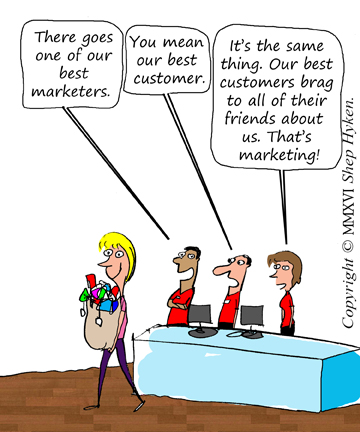
While going above and beyond for your customers will mean something different depending on your industry, there are a number of stories you can check out for inspiration on how to do so, including ones about:
- The Zappos employee who bought shoes from a competing brand for a customer in need
- The Trader Joe’s employee who delivered groceries to an elderly customer during a snowstorm
- Chick-fil-A’s team doing what they do best
As we said earlier, ensuring customer satisfaction is all about being attentive and responsive to your customers’ needs, and doing anything in your power to help.
In each case, the company in question didn’t need to do what they did, but they did—and that’s why we’re still telling their stories all these years later.
4. Add Value at Every Opportunity
In the previous section, we talked about giving your customers more than they expect whenever they engage with your brand.
But this doesn’t necessarily mean you need to give, give, give of yourself whenever you do so. It certainly is possible to provide more value to your customers while also reaping benefits for your company, as well.
For example, if you run an ecommerce company that sells guitars, you can provide cross-sell offers of accessories like cases, amplifiers, and lesson books to add to the value of your “main” offering:

(Source / Not sure why you’d buy a Fender shirt while buying a Martin guitar, but anyway...)
Think about it like this:
If you sell a customer a set of golf clubs, you’ve enabled them to play golf. If you sell them a set of golf clubs, a pair of golf shoes, an outfit, and three professional lessons, you’ve enabled them to become a golfer.
Basically, your goal is to expose your customers to all of the things you offer that they’ll find valuable.
At the very least, doing so will be an investment for the future, as it will make the customer more likely to return at a later date.
Best-case scenario, though, staying focused on providing value to your customers at all times can lead to immediate gains for your brand.
5. Provide Multichannel or Omnichannel Support
As you surely know, your job isn’t done once you’ve made a sale.
Your job isn’t even done once your customer has reached their intended goals.
Heck, we’d even say that once you’ve brought a customer on board, you have a sworn duty to help them overcome their problems for life.
(At least, that should be your goal. The longer you keep your customers on board, the better!)
Anyway, the point is, to keep them satisfied and truly happy with your brand, you’ll need to provide ongoing service and support to them from time to time.
Now, when we say “From time to time,” what we really mean is, “When your customers need it, where they expect to get it.”
That is, the modern customer expects brands to be available and responsive on a variety of different channels—and is becoming more impatient with companies that don’t meet these expectations.
This is why a multichannel—or, better yet, omnichannel—approach to customer service is key in today’s world. While the more nuanced differences between these two options are a discussion for another time, the main difference can be laid out as such:
- Multichannel customer service involves separate teams for different channels (e.g., a phone team, live chat team, and an email team)
- Omnichannel customer service involves merging the data from all these channels to create a cohesive and seamless approach onto solving the customer’s problems regardless of which channel is being used

(Source)
By today’s standards, even the smallest of companies should offer multichannel support to its customers.
Not only is it relatively easy to provide a self-service option like a knowledge base or wiki as well as make yourself available via, say, email, Facebook Messenger, and telephone, but being available on more channels adds another point of value to your brand.
Over time, though, your goal in this regard should be to build an omnichannel system of customer service and support throughout your company.
As we said earlier, this means integrating your service teams, as well as the information they take in, store, and communicate.
Continuing with the above example, this might mean taking in messages through voice mail, then responding via phone call, text message, and/or email at your customer’s request.
If you’re looking for a way to provide responsive, helpful, and retentive customer service, an omnichannel approach to customer service is essential to your company.
6. Monitor Social Media
It's likely that at least some of your current customers use social media to share their experiences with a company's products or services. This can include both positive and negative experiences. Customers may post reviews or ratings on a company's social media accounts or on third-party review websites, or they may share their experiences with friends and followers on their personal social media accounts.
That's why it's important to regularly monitor the social media platforms that your target audience is using so you can identify customer issues or concerns and address them in a timely manner. This can help to prevent dissatisfaction and build trust with customers.
When a customer does mention your company, particularly with an inquiry or a complaint, try to respond as promptly as possible to show that you value your customers and are committed to addressing their concerns.
7. Allow Self-Service Whenever Possible
While you might not have the bandwidth to provide live service to your customers at all times, you’ll at least want to provide some level of accessible support 24/7.
Perhaps the most effective approach, here, is to enable self-service whenever logistically possible.
(To be sure, self-service software and automated transactions are essentially what allow ecommerce and other online businesses to thrive in the first place.)
But, more than simply automating certain transactional processes, you’ll also want to allow your customers to help themselves as best they can before needing to reach out to your service team.
In developing a self-service knowledge base for your customers, your support team will dig into both common and uncommon issues your current audience faces over time, and create in-depth solutions to each.

As shown in the example above, Meijer home delivery provides answers to commonly-asked questions and more by making use of knowledge base software.
In turn, both current and potential customers can get the information they need from Meijer—right when they need it.
The benefit of creating self-service solutions for your customers in need of support is twofold:
For one, you’ll save time and other resources in the long run, as your service team won’t need to be “hands on” for smaller issues your customers can now take care of on their own. In turn, your team can invest more time and energy into tackling the larger customer issues that come their way.
Secondly, by proactively providing support documentation and other such info to your customers, you again make it clear that you truly care about their circumstances, and will do whatever it takes to help them succeed.
8. Improve Employee Satisfaction and Engagement
Here’s the deal:
The happier your employees are, the more engaged in their duties they’ll be. The more engaged they are, the better they’ll be at giving their customers exactly what they want. When your customers get what they want (and more), they’ll be happy.
"It all boils down to dealing with employees who are happy, aligned and engaged in their work which just FEELS better for the customer.
You have probably experienced this first hand whereby you were served by an employee and you had the sense that the person would rather be anywhere other than helping you as a client. You have probably also experienced the opposite example whereby you are served by someone who takes a genuine interest in you and wants to help you solve your challenge or ensure you get what you need. The latter just FEELS better!
By ensuring that you have the right people in the right roles doing work that they love, your customers will sense this and will walk away having had a better experience with your company." - Cal Misener, Chief Happiness Officer at High Performance Culture.
So, by increasing your employees’ satisfaction levels, you’ll end up positively affecting your customer satisfaction, as well.
According to Cal Misener, "the simple formula is happy employees = happy customers = happy shareholders."
And this isn’t just conjecture; it’s a fact.
A study conducted at Washington State University took this statement even a step further, showing that, due to this direct relationship, employee satisfaction also plays a major role in a company’s overall financial situation, as well.
Now, your approach for getting your employees more engaged in their work will depend on a variety of factors.
Above all else, though, it requires you gain a true understanding of where they stand within their own hierarchy of needs.

(Source)
For those unfamiliar with Maslow’s Hierarchy of Needs in psychological terms, the premise is that people in general must have certain prerequisite needs met before they can become more fully autonomous and self-actualized.
As the image above shows, when applied to employee engagement, the hierarchy details the continuum employees follow on their way to becoming what any manage would consider a “model employee.”
That is to say that, for example, employees who are “only here for a paycheck,” or who tend to count down the seconds until quitting time aren’t going to become highly-engaged employees overnight.
While we won’t get into the nitty-gritty of how to improve employee engagement on a granular level here, what we will say is this:
If your employees’ basic needs—as employees and as people—aren’t met, there’s no way they’ll ever be able to reach the level of engagement you’d like them to.
That said, the onus is on you, as the owner or manager of your organization, to ensure your team members have everything they need to succeed and grow.
9. Actively Solicit and Act on Feedback
We talked about this in-depth much earlier, so we’ll just reiterate here:
If you want to improve your customers’ satisfaction levels, you absolutely need to reach out to them to find out what it is they actually want from you. More importantly, you need to take action upon receiving this feedback to either:
- Rectify the situation on an individual level
- Begin making improvements to your overall operations as needed
"If many customers encounter the same problem or find it difficult to do something, maybe there are things you should change. Talk to your clients, listen to their issues and advice. You'll have a better understanding of what needs to be worked on in order to satisfy your customers' needs." - Marie Lamonde, Marketing, DashThis
On either an individual or macro level, the goal is again the same:
Reassure your customers that you’re dedicated to helping them solve their problems, and making the changes necessary to make it happen.
Satisfied Customers, Successful Business: The Importance of Customer Satisfaction
Ensuring customer satisfaction is, at its core, a pretty simple task.
After all, all you need to do is exceed your customers’ expectations at all times, right?
All kidding aside, satisfying your customers (and more) each and every time they engage with your brand is a monumental and ongoing task.
And that’s okay; it’s supposed to be.
By staying laser-focused on staying one step ahead of your customers’ expectations at all times—and following through by consistently providing added value to their experiences—you’ll end up leaps and bounds ahead of your competition, as well. In turn, you’ll easily be able to position your brand as the go-to within your industry.

Using Helpjuice to Improve Customer Satisfaction
Knowledge bases are used by companies in a variety of industries as a way to further connect with consumers and enhance customer satisfaction across the board.
By providing valuable, easily-accessible information to their customers with no questions asked, brands that use knowledge bases like Helpjuice can quickly build trust among their audience
Helpjuice enable brands to provide valuable, easily-accessible information to their customers free of charge, they’re a necessary part of any company’s customer satisfaction game plans.
Check out Helpjuice’s key features to learn more.

